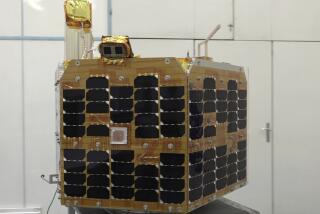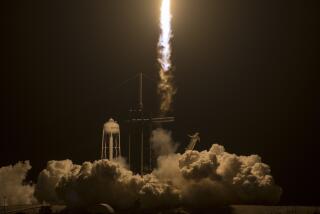Loss of satellite is ‘serious setback’ for Earth climate research
- Share via
The loss of a sophisticated observation satellite in the wake of a NASA rocket launch failure has dealt a major blow to scientific efforts aimed at understanding how humans may be affecting Earth’s climate.
A nine-story Taurus XL rocket carrying the space agency’s Glory satellite was launched early Friday from Vandenberg Air Force Base in Santa Barbara County. The satellite crashed into the Pacific Ocean minutes later, without reaching orbit, after its protective casing failed to open.
The satellite carried technologically advanced equipment to help scientists understand how solar irradiation, clouds and particles of matter in the atmosphere called aerosols affect Earth’s climate.
Scientists said the new instruments would have distinguished more accurately the difference between such natural particles as desert dust and particles from such human activities as burning coal and spraying nitrate fertilizers.
“The loss of the Glory satellite is a serious setback to our capacity to continue observations critical to understanding and predicting the Earth’s climate,” said Greg Holland, director of the Earth System Laboratory of the National Center for Atmospheric Research, which is based in Boulder, Colo.
The failure of the $424-million mission comes at a time of heightened controversy over the accuracy of climate predictions, with the oil and coal industries financing attacks on the integrity of scientific research and mounting a lobbying effort in Congress to halt proposed curbs on fossil fuel burning.
A climate satellite launch in 2009, the Orbiting Carbon Observatory, also crashed under circumstances similar to Friday’s accident.
Meanwhile, the proposed 2012 federal budget would postpone a major climate science program known as the Climate Absolute Radiance and Refractivity Observatory.https://clarreo.larc.nasa.gov/
“There is a huge hole building in the U.S. contribution to Earth and sun observing systems,” NASA scientist Gavin Schmidt warned over the weekend on RealClimate.org, a climate scientists’ blog. “Working from space is hard, expensive and risky. We cannot take it for granted, and yet we need that information more than ever.”
The Glory satellite contained a Total Irradiance Monitor that would have extended decades-long observations of solar radiation entering the atmosphere, “a critical parameter in assessing and predicting the impacts of climate variability,” Holland said.
Another instrument, an Aerosol Polarimetry Sensor, could have detected aerosols over bright land surfaces and differentiated among sulfates from ocean plankton and coal burning, dust from deserts, black carbon from burning forests or cooking outdoors, sea salt, nitrates, pollen and other aerosols that had been indistinguishable by previous remote sensing equipment.
Without such equipment, Schmidt said, “we can’t easily distinguish what’s what from space … how much of the aerosol is anthropogenic and how much is natural.”
More to Read
Inside the business of entertainment
The Wide Shot brings you news, analysis and insights on everything from streaming wars to production — and what it all means for the future.
You may occasionally receive promotional content from the Los Angeles Times.











